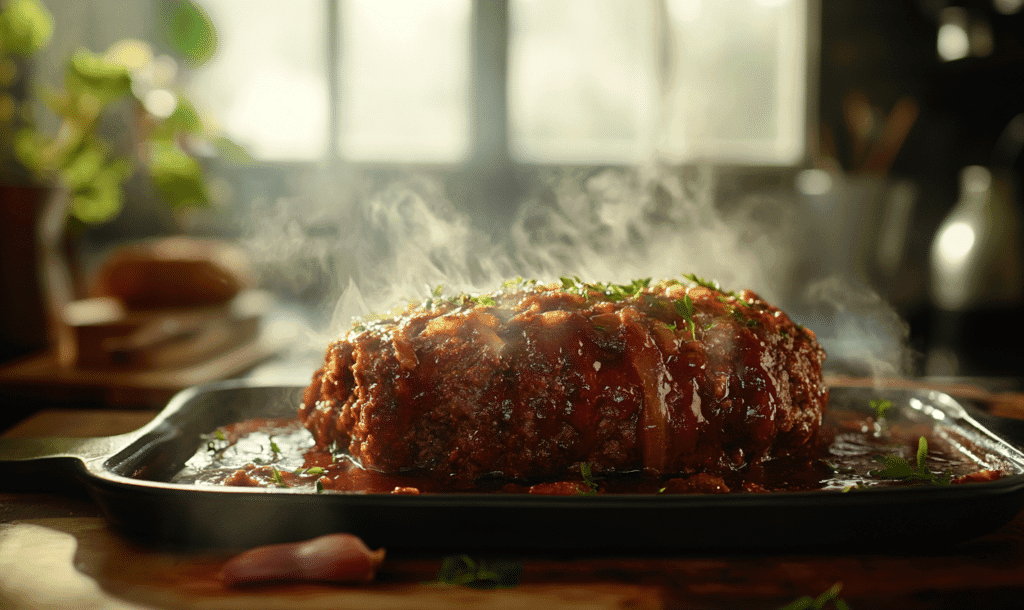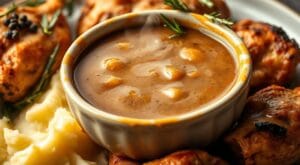Jump to:
Estimated reading time: 12 minutes
Table of contents
Introduction
Bread crumb in Meatloaf is a beloved comfort food, cherished for its savory flavor and tender texture. However, achieving the perfect meatloaf requires careful attention to ingredients, especially the bread crumbs. Bread crumbs play a crucial role in binding the meat mixture, but what happens if you put too much bread crumbs in meatloaf? Overdoing it can significantly alter the texture and taste, resulting in a dry, dense, or crumbly dish. This article will delve into the consequences of adding too many bread crumbs and provide practical tips for making sure your meatloaf turns out just right. Additionally, we will explore whether you should bake meatloaf in glass or metal pans for the best results.
Why Choose the Right Amount of Bread crumb in Meatloaf?
Understanding the role of bread crumbs in meatloaf is essential to mastering this classic dish. Bread crumbs serve multiple purposes: they help bind the meat mixture, retain moisture, and add texture. When used in the right amount, bread crumbs contribute to a well-structured, moist, and flavorful meatloaf. However, if you put too much bread crumbs in meatloaf, it can lead to undesirable results, such as dryness and crumbliness. Moreover, the decision to bake meatloaf in glass or metal can also impact the final texture and cooking time, making it crucial to choose wisely.
The Role of Bread Crumb in Meatloaf
Bread crumbs act as a filler that stretches the meat mixture while also providing a binding element. When mixed with liquids such as milk or eggs, the bread crumbs absorb moisture and create a cohesive texture that holds the meatloaf together during baking. This combination prevents the meatloaf from falling apart when sliced.
However, the amount of bread crumbs used should be balanced. Too few bread crumbs can result in a dense, tough meatloaf that falls apart. Conversely, too many bread crumbs can overpower the meat, leading to a dry and crumbly texture. Additionally, the choice of pan—whether you bake meatloaf in glass or metal—can influence the outcome, as different materials conduct heat differently.
What Happens If You Put Too Much Bread Crumb in Meatloaf?
Adding too many bread crumbs to your meatloaf can have several negative consequences. Here are some common issues that arise when the bread crumb ratio is off:
Bread crumb in meatloaf: Dry and Dense Texture
One of the most common problems when you put too much bread crumbs in meatloaf is a dry and dense texture. Bread crumbs are absorbent, and when there are too many, they soak up more moisture from the meat mixture than necessary. This excess absorption leaves the meatloaf with less moisture, resulting in a dry, heavy, and unappealing dish. To avoid this, it’s important to follow a recipe’s guidelines on the quantity of bread crumbs or to adjust based on the specific moisture content of your ingredients.
Bread crumb in meatloaf: Crumbliness and Lack of Cohesion
Another issue that arises from using too many bread crumbs is crumbliness. Bread crumbs are supposed to bind the ingredients together, but when overused, they can cause the meatloaf to crumble and fall apart. This is because the meat mixture becomes too dry and loses its natural stickiness, which is crucial for holding the loaf together. Ensuring the right balance between meat, liquid, and bread crumbs is key to maintaining the meatloaf’s structure.
Bread Crumb in meatloaf: Overpowering Bread Flavor
When you put too much bread crumbs in meatloaf, the flavor balance can be thrown off. Instead of the rich, meaty taste you’d expect, the bread flavor can become too pronounced, overpowering the other ingredients. This can make the meatloaf taste bland or overly starchy, diminishing the overall enjoyment of the dish. To maintain a harmonious flavor profile, it’s essential to keep the bread crumbs at a reasonable level.
Bread Crumb in Meatloaf: Longer Cooking Time
Interestingly, an overabundance of bread crumbs can also affect the cooking time of your meatloaf. Because bread crumbs absorb moisture and thicken the mixture, they can increase the overall density of the meatloaf. This means it may take longer to cook through, especially if you choose to bake meatloaf in glass or metal pans. Glass, in particular, heats up more slowly than metal, which could further extend the cooking time and exacerbate the problem of dryness.

Bread Crumb in Meatloaf: Ingredients Overview
What You’ll Need for Perfect Meatloaf
To make a perfectly balanced meatloaf, you’ll need the following ingredients:
- 500g ground beef or a mix of ground meats (beef, veal)
- 100g bread crumbs (start with less if you’re unsure)
- 1 medium onion, finely chopped
- 2 garlic cloves, minced
- 1 egg, lightly beaten
- 100ml milk
- 50g ketchup (plus extra for topping)
- 1 tablespoon Worcestershire sauce
- 1 teaspoon salt
- 1/2 teaspoon black pepper
- 1 teaspoon dried thyme
- 1 teaspoon dried oregano
Substitutions to Customize Your Meatloaf
Customizing your meatloaf to suit different dietary needs or ingredient availability is easy. Here are some substitution ideas:
- Gluten-Free: Replace regular bread crumbs with gluten-free bread crumbs or crushed gluten-free crackers.
- Low-Carb: Use almond flour as a low-carb alternative to bread crumbs.
- Dairy-Free: Substitute milk with a dairy-free alternative like almond milk or oat milk.
- Meat Varieties: If you prefer a lighter meatloaf, substitute ground beef with ground turkey or chicken.
- Vegetarian: Use lentils, mushrooms, or a plant-based ground meat substitute instead of traditional ground meat, and adjust the seasoning accordingly.
These substitutions allow you to tailor the meatloaf to specific tastes and dietary restrictions while still achieving a delicious and satisfying result.
Bread crumb in Meatloaf: Step-by-Step Preparation of Meatloaf
Creating the perfect meatloaf involves careful attention to each step of the process. Below is a detailed guide to ensure your meatloaf turns out just right, regardless of whether you bake meatloaf in glass or metal pans.
First Step: Preparing the Ingredients
Begin by gathering all your ingredients. Finely chop the onion and mince the garlic. Measure out the bread crumbs, milk, and seasonings. This step is crucial because it allows you to ensure that you have the correct proportions, avoiding the pitfall of adding too much bread crumbs.
Second Step: Mixing the Meatloaf Base
In a large mixing bowl, combine the ground meat with the chopped onion, garlic, egg, milk, Worcestershire sauce, ketchup, and seasonings. Mix these ingredients gently with your hands or a large spoon until they are just combined. Avoid overmixing, as this can make the meatloaf tough.
Third Step: Incorporating the Bread Crumbs
Gradually add the bread crumbs to the meat mixture. Start with half of the amount you plan to use, then mix it in lightly. Assess the texture of the mixture; it should be moist but firm enough to hold its shape. Add more bread crumbs as needed, but be cautious not to add too much. The mixture should feel cohesive but not overly dry or dense.
Fourth Step: Shaping the Meatloaf
Once the mixture is well-combined, shape it into a loaf. Place the meatloaf in a baking dish. If you’re deciding whether to bake meatloaf in glass or metal pans, remember that glass takes longer to heat but retains heat better, resulting in a more evenly cooked loaf. Metal pans, on the other hand, heat up faster, which can create a crustier exterior.
Fifth Step: Baking the Meatloaf
Preheat your oven to 180°C (350°F). If you’ve chosen to bake meatloaf in glass or metal, place the meatloaf in the middle of the oven to ensure even cooking. Depending on the size and density of your meatloaf, bake for 50-60 minutes, checking the internal temperature toward the end of cooking. The meatloaf is done when it reaches an internal temperature of 70°C (160°F).
Sixth Step: Adding the Topping
About 10 minutes before the meatloaf is done, you can add a topping of ketchup or a glaze made from a mixture of ketchup, brown sugar, and mustard. Spread it evenly over the top of the loaf and return it to the oven to finish cooking. This step adds a sweet and tangy flavor to the meatloaf and helps seal in moisture.
Final Step: Resting and Serving
Once the meatloaf is fully cooked, remove it from the oven and let it rest for about 10 minutes. This resting period allows the juices to redistribute throughout the loaf, making it easier to slice and serve. After resting, slice the meatloaf and serve with your favorite sides, such as mashed potatoes, steamed vegetables, or a fresh salad.
Enhancing Meatloaf: Tips and Variations
Perfecting meatloaf is an art, and there are several tips and variations you can explore to enhance your dish further. Here are some ideas to make your meatloaf stand out:
Adding Vegetables for Moisture
Incorporating finely grated vegetables like carrots, zucchini, or mushrooms into your meatloaf mixture can add moisture and flavor, helping to counteract the effects of too many bread crumbs. Vegetables not only boost the nutritional value of the meatloaf but also create a more complex flavor profile.
Experimenting with Different Meats
While beef is the traditional choice for meatloaf, experimenting with different meats can lead to exciting new flavors. A mixture of beef, and veal (often referred to as a meatloaf mix) creates a rich and tender loaf. Alternatively, using ground turkey or chicken results in a lighter, leaner meatloaf.
Using Flavored Bread Crumbs
If you’re looking to add a new twist to your meatloaf, consider using flavored bread crumbs. Italian-seasoned bread crumbs can infuse your meatloaf with additional herbs and spices, enhancing the overall flavor. Just be mindful of the salt content in flavored bread crumbs to avoid oversalting your dish.
Creating a Stuffed Meatloaf
For an impressive presentation and added flavor, try making a stuffed meatloaf. After shaping the meat mixture into a flat rectangle, place a filling of your choice—such as cheese, sautéed spinach, or cooked bacon—down the center. Roll the meat around the filling and then bake as usual. This variation adds a delightful surprise in every slice.
How to Store Meatloaf
Proper storage is key to enjoying your meatloaf leftovers. Whether you bake meatloaf in glass or metal pans, the storage method remains the same.
Refrigeration
After the meatloaf has cooled to room temperature, wrap it tightly in plastic wrap or aluminum foil, or place it in an airtight container. Store it in the refrigerator for up to 3-4 days. When you’re ready to eat it again, you can reheat individual slices in the microwave or reheat the whole loaf in the oven at a low temperature to retain moisture.
Freezing
Meatloaf freezes exceptionally well, making it a great option for meal prepping. To freeze, wrap the cooled meatloaf tightly in plastic wrap and then in aluminum foil to prevent freezer burn. Alternatively, you can slice the meatloaf and freeze the slices individually for easier portioning. Frozen meatloaf can be stored for up to 3 months. To reheat, thaw it in the refrigerator overnight and then warm it in the oven until heated through.
Nutritional Benefits of Meatloaf
Meatloaf can be a nutritious addition to your meal plan, providing a good balance of protein, carbohydrates, and fats. The nutritional content will vary depending on the ingredients used, but here’s a general overview of what you can expect:
- Protein: Meatloaf is rich in protein, especially if made with lean ground meat. A typical serving can provide about 20-25 grams of protein, essential for muscle repair and growth.
- Carbohydrates: The bread crumbs and other fillers contribute to the carbohydrate content, which can be adjusted based on your dietary needs. A standard slice of meatloaf might contain around 10-15 grams of carbohydrates.
- Fats: The fat content in meatloaf depends on the type of meat used. Ground beef, particularly higher-fat varieties, will contribute more saturated fat, while leaner meats like turkey provide less. Fat content can range from 10-20 grams per serving.
- Vitamins and Minerals: Meatloaf provides essential vitamins and minerals, including iron, zinc, vitamin B12, and niacin. Adding vegetables can increase the fiber and vitamin content, making the dish even more nutritious.
Frequently Asked Questions: bread crumb in meatloaf
How Do I Fix Meatloaf That’s Too Dry?
If your meatloaf turns out too dry, despite following the recipe, there are a few remedies you can try. Adding a sauce or gravy on top can help reintroduce moisture. You can also slice the meatloaf and cook the slices in a pan with a bit of broth or tomato sauce to add moisture back into the dish. Finally, ensuring that you don’t overbake the meatloaf is crucial—using a meat thermometer to check for doneness can prevent this issue.
Should I Bake Meatloaf in Glass or Metal Pans?
Deciding whether to bake meatloaf in glass or metal pans depends on your preference for texture and cooking time. Glass pans take longer to heat up but provide a more even cooking process, which can prevent the meatloaf from becoming too dry.
Can I Make Meatloaf Without Bread Crumbs?
Yes, you can make meatloaf without bread crumbs by using alternatives such as oats, crushed crackers, or almond flour. These substitutes can provide a similar binding effect while catering to specific dietary needs, such as gluten-free or low-carb diets.
How Do I Prevent Meatloaf from Falling Apart?
To prevent your meatloaf from falling apart, ensure that you use the right balance of ingredients. The egg acts as a binder, so don’t skip it unless you have a suitable substitute.
How Long Should I Let Meatloaf Rest Before Slicing?
Allowing the meatloaf to rest for about 10-15 minutes after baking is important for retaining its shape and moisture. Cutting into the meatloaf too soon can cause it to crumble or release too much juice, making the slices less appealing. Letting it rest allows the juices to redistribute throughout the loaf, resulting in cleaner slices and a more enjoyable texture.
Conclusion
Understanding what happens if you put too much bread crumbs in meatloaf is crucial for mastering this classic dish. By maintaining the right balance of ingredients and following proper cooking techniques, you can ensure a tender, flavorful meatloaf every time. Whether you choose to bake meatloaf in glass or metal pans, or experiment with different variations, the key is to focus on achieving the right texture and moisture levels. With the tips and insights provided in this article, you’re well on your way to creating a perfect meatloaf that your family and friends will love.






